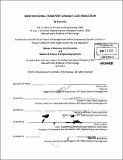| dc.contributor.advisor | Charles H. Fine and Daniel E. Whitney. | en_US |
| dc.contributor.author | Xia, YuXin, M.B.A. Sloan School of Management | en_US |
| dc.contributor.other | Leaders for Global Operations Program. | en_US |
| dc.date.accessioned | 2011-09-27T18:35:24Z | |
| dc.date.available | 2011-09-27T18:35:24Z | |
| dc.date.copyright | 2011 | en_US |
| dc.date.issued | 2011 | en_US |
| dc.identifier.uri | http://hdl.handle.net/1721.1/66038 | |
| dc.description | Thesis (M.B.A.)--Massachusetts Institute of Technology, Sloan School of Management; and, (S.M.)--Massachusetts Institute of Technology, Engineering Systems Division; in conjunction with the Leaders for Global Operations Program at MIT, 2011. | en_US |
| dc.description | Cataloged from PDF version of thesis. | en_US |
| dc.description | Includes bibliographical references (p. 146-148). | en_US |
| dc.description.abstract | The M28 is a Polish short-takeoff-and-landing (STOL) light cargo aircraft developed in 1984 and currently built by PZL Mielec, a subsidiary of United Technology Corporation (UTC). There has been renewed interest in the product from military and commercial markets due to its impressive STOL capabilities. However, in order to become price-competitive, its cost would need to be reduced significantly. Multiple cost-reduction concepts have been proposed by the manufacturing and procurement groups. An Optimization Team was also formed to lead the cost-reduction effort. However, a more systematic approach is required in order to achieve the ambitious reduction goals. The proposed solution is to create a top-down systematic cost-reduction framework used to coordinate and prioritize the team's current bottom-up approach. A top-down cost reduction strategy was developed based on UTC Otis' Octopus Fishing concept. Such methodology, heavily finance driven, systematically breaks M28 into sub-systems, and prioritizes improvement recommendations based on cost-reduction potentials. It also leverages on the wealth of knowledge from global cross-functional teams to generate explosive amount of improvement recommendations. The sub-systems were benchmarked against competitors cost structures. The framework will be linked to concepts generated from the database to create a process that combine top-down and bottom-up approaches. After tasks were prioritized using the outlined framework, a three-prong approach was implemented to enhance cost reduction capability. Manufacturing of labor intensive parts such as nacelle deflection cover was automated using CNC machines. A set of commodity purchasing strategies were formulated for forgings, avionics, raw materials, interior and composite materials. Lastly, a discrete Kaizen event was described to aid redesign-for-manufacturing. | en_US |
| dc.description.statementofresponsibility | by Yuxin Xia. | en_US |
| dc.format.extent | 153 p. | en_US |
| dc.language.iso | eng | en_US |
| dc.publisher | Massachusetts Institute of Technology | en_US |
| dc.rights | M.I.T. theses are protected by
copyright. They may be viewed from this source for any purpose, but
reproduction or distribution in any format is prohibited without written
permission. See provided URL for inquiries about permission. | en_US |
| dc.rights.uri | http://dspace.mit.edu/handle/1721.1/7582 | en_US |
| dc.subject | Sloan School of Management. | en_US |
| dc.subject | Engineering Systems Division. | en_US |
| dc.subject | Leaders for Global Operations Program. | en_US |
| dc.title | M28 Fixed wing transport aircraft cost reduction | en_US |
| dc.type | Thesis | en_US |
| dc.description.degree | S.M. | en_US |
| dc.description.degree | M.B.A. | en_US |
| dc.contributor.department | Leaders for Global Operations Program at MIT | en_US |
| dc.contributor.department | Massachusetts Institute of Technology. Engineering Systems Division | |
| dc.contributor.department | Sloan School of Management | |
| dc.identifier.oclc | 752198491 | en_US |
